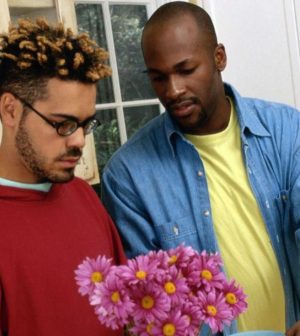- Skip Storing This Everyday Product in the Fridge Door
- Green Tea + B3 Pairing May Boost Brain Health
- Navigating Your Midlife Crisis: Embracing New Possibilities
- City Raccoons Showing Signs of Domestication
- Mapping the Exposome: Science Broadens Focus to Environmental Disease Triggers
- One Week Less on Social Media Linked to Better Mental Health
- Your Brain Changes in Stages as You Age, Study Finds
- Some Suicide Victims Show No Typical Warning Signs, Study Finds
- ByHeart Formula Faces Lawsuits After Babies Sickened With Botulism
- Switch to Vegan Diet Could Cut Your Greenhouse Gas Emissions in Half
HIV Rates Fall Among Gay White Americans, But Not Minorities

Some progress has been made in the U.S. fight against HIV, with new infections falling among white gay and bisexual men over the past decade. But their Black and Hispanic counterparts did not see that advance, health officials say.
The continuing inequities show up in a new report from the U.S. Centers for Disease Control and Prevention.
From 2010 to 2019, the number of new HIV infections among white gay/bisexual men fell from 7,500 to 5,100, but remained about the same among Black gay/bisexual men (9,000 to 8,900) and rose among Hispanic gay/bisexual men (from 6,800 to 7,900), researchers found.
“Throughout my career, I have witnessed a transformation for those living with and at risk for HIV,” CDC Director Dr. Rochelle Walensky said in an agency news release.
“We have the scientific tools to end the HIV epidemic,” Walensky added. “However, to achieve this end we must acknowledge that inequities in access to care continue to exist and are an injustice. We must address the root causes of these ongoing disparities and make proven HIV prevention and treatment intervention available to all.”
Black and Hispanic gay/bisexual men were less likely to receive an HIV diagnosis, be virally suppressed or use pre-exposure prophylaxis (PrEP) to prevent HIV, compared with white gay/bisexual men, according to the CDC Vital Signs report.
For example, in 2019 researchers found that about 83% of Black and 80% of Hispanic gay/bisexual men with HIV had been diagnosed, compared with 90% of white men. About two-thirds of Black or Hispanic gay/bisexual men with diagnosed HIV were virally suppressed, compared with three-quarters of white gay/bisexual men.
Unequal reach of HIV prevention and treatment, higher levels of HIV in some communities, and systemic inequities are among the reasons for these racial disparities, according to the report. It was released in conjunction with World AIDS Day on Wednesday.
HIV-related stigma may also play a role. A nationally representative survey of people diagnosed with HIV found that Black and Hispanic gay/bisexual men were more likely than white gay/bisexual men to report experiencing HIV-related stigma.
The CDC is working with partners through a federal initiative called Ending the HIV Epidemic in the United States to reduce HIV infections by 90% by 2030.
More information
The U.S. Centers for Disease Control and Prevention has more on HIV risks and prevention.
SOURCE: U.S. Centers for Disease Control and Prevention, news release, Nov. 30, 2021
Source: HealthDay
Copyright © 2025 HealthDay. All rights reserved.










